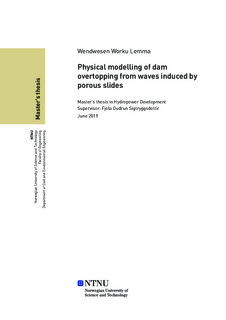| dc.description.abstract | A landslide falling into a reservoir transfers its kinetic energy to wave energy. This wave energy generates an impulse wave that propagates away from the impact zone of the landslide. The generated impulse wave may cause damage as it runs up the shores or against the dam structure. Such large waves may cause hazardous consequences to the downstream area of the reservoir. Such is the case in the Vajont dam failure of 1963 in Italy, which was the cause of the loss of more than 2000 people.
The work in this thesis is an experimental study performed on a conceptual physical model with a scale of 1:190. The physical model simulates a real situation of a landslide into a reservoir and the possible consequences of this landslide. The main objective of this study is to investigate dam overtopping due to waves induced by a landslide into a reservoir and compare the presented experimental results of using porous blocks and solid blocks. For this experimental study, 123 laboratory tests were carried out.
A comparison of the experimental result of using a porous block to a solid block has been performed. For both solid and porous blocks, a similar wave pattern was observed. The generated wave amplitude ratio (a solid block/a porous block) was in the range of 0.88 to 1.67. The impact of different model parameters and slide properties on the overtopping volume, on the maximum overtopping depth, and on the wave generated is studied. The generated wave height is greatly dependent on the release height, weight, and porosity of the block. The release height, weight, and porosity of the block have an impact on both the overtopping volume and the maximum overtopping depth over the dam crest. The comparison result of the porous and solid block was compared to the literature results, and quite similar results were observed to Heller and Spinneken, (2013) and Ataie-Ashtiani and Nik-Khah, (2008). Additionally, the actual overtopping volume and overtopping depth along the dam crest are compared to the overtopping volume and maximum overtopping depth calculated by Kobel et al. (2017). Kobel et al. (2017) overestimate the overtopping volume; the ratio of V Kobel/V measured falls in the range of 1.46 to 2.7. But close results are observed for the maximum overtopping depth over the dam crest except for few results. | |
